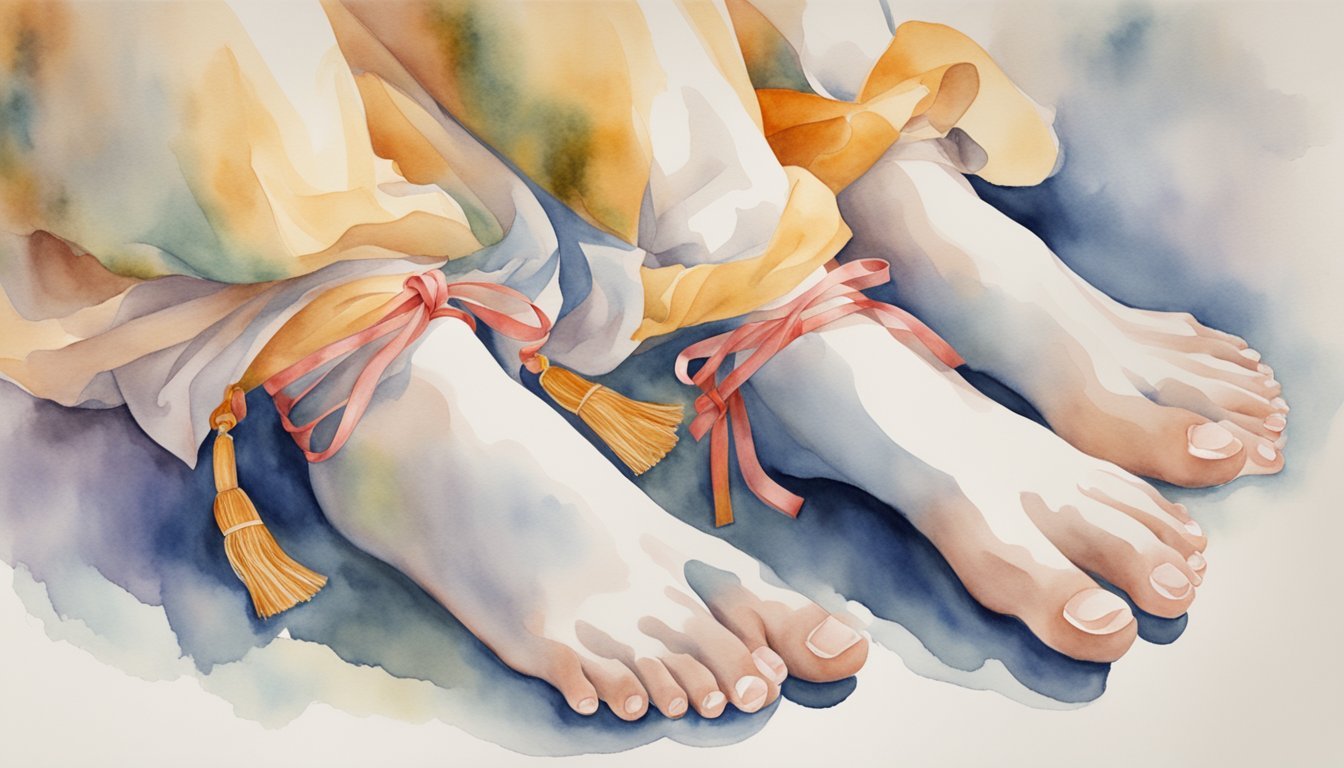Practices and Implications of Foot Binding
Foot binding was a deeply ingrained cultural practice in China, reflecting complex notions of beauty, status, and gender roles. This section explores the meticulous process, its profound impact on society and women, and the serious health repercussions.
Process and Technique
The process of foot binding began between the ages of three to eleven, before the arches were fully developed. Feet were soaked in hot water and then the toes were bent toward the sole, creating a curve. Long strips of cloth, usually cotton or silk, were tightly wrapped around the foot to hold the toes in place. Over time, this practice aimed to achieve the “Three-Inch Golden Lotus,” a term for the ideal small, arched foot size.
Social and Personal Impact
Foot binding carried significant implications for Chinese women’s social standing and marriage prospects. Small feet were seen as beautiful and a sign of femininity. The mobility restrictions it caused also meant that bound feet became a symbol of a woman’s inability to participate in labor-intensive work, denoting higher social status and privilege.
Health Consequences and Opposition
The consequences of foot binding were painful and often severe, involving broken bones, lifelong disabilities, and infections. Complications such as gangrene could even lead to death. Despite the popularity of the practice, there was substantial opposition from those who saw it as a form of mutilation, including missionaries and some Chinese reformers, who eventually contributed to its decline.
Cultural Significance and Current Perception

Foot binding was a Chinese custom that profoundly influenced women’s status and societal roles. This ancient tradition, emphasizing small “lotus feet,” was once considered essential for marriage prospects and a symbol of beauty and status in China.
Legacy and Reflection
The legacy of foot binding extends beyond physical implications, leaving a complex historical footprint. In ancient China, the ideal of the “Three-Inch Golden Lotus” epitomized feminine beauty and often determined a woman’s social hierarchy and marriage prospects. This painful process, starting in childhood, wrapped the feet to restrict growth, resulting in life-long disabilities. Scholars at Stanford University highlight that despite the suffering, foot binding was a source of pride and cultural identity for many women. The transition away from foot binding, particularly following the Qing Dynasty and into the Republic of China, symbolizes a cultural shift towards rejecting the oppressive elements of this practice. The ban on footbinding by the Communists served as a catalyst for this change.
Modern-Day Perspective and Education
Today, foot binding is widely condemned, recognized as a form of child abuse and extreme subjugation. Education on this topic, along with other historical examples of cultural practices impacting women, is necessary for cultivating cultural awareness and understanding historical contexts. In contemporary discussions, the fates of elderly Chinese women who underwent foot binding serve to educate and remind current generations of the practice’s severity. The last practitioners of foot binding are a living testament to the tradition’s dark history, which is addressed in educational resources like the Harvard Gazette. Advocating for the education on the history and consequences of foot binding is also a call for wider recognition of patterns of oppression and the importance of societal change.
The examination of this brutal tradition in China provides a window into how a society’s pursuit of beauty standards and status symbols can lead to lasting physical and psychological pain. It invites reflection on how such cultural practices are remembered and discussed in a modern context that values human rights and gender equality.

